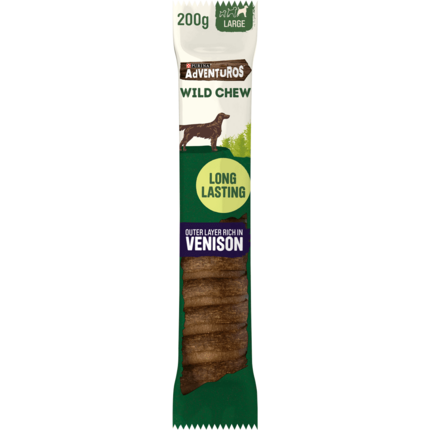
It’s not uncommon for a dog to have ticks. These pesky parasites are very adept at attaching themselves to your dog’s coat, even if you do your best to avoid them. Luckily there are simple ways to help prevent, and treat, ticks on dogs.
What are dog ticks?
Ticks are eight-legged parasites that bite your dog to drink their blood. Although dog ticks are very tiny, they can swell up to the size of a pea once they’ve attached themselves to your dog by burying their mouthparts into their skin.
There are several types of tick that can affect dogs in the UK, including dog ticks, sheep ticks and hedgehog ticks. They can also bite humans too, and some ticks can transmit diseases.
How do I spot ticks on my dog?
Dog ticks are just large enough to be visible, especially if they’ve already had a bite – then they can look like small warts, and on closer inspection you can see their legs, too. You’ll usually find them around your dog’s head and neck area - just part your dog’s fur and run your fingers along their skin. Tick bites on dogs can also cause irritation and redness.
The best time to check your dog for ticks is as soon as you get back from your daily walks. Be sure to check for any lumps and bumps as ticks will usually feel similar to a small bump (which can sometimes be mistaken for a little skin swelling or mass). The key areas to inspect are the head, neck, ears and feet as these are where they’re most commonly found.
Ticks can start to pass on diseases in as little as 24 hours, so it is important that they’re found and removed as soon as possible in order to reduce the risk of transmission of potentially harmful organisms.
Removing a tick from a dog can be difficult because it’s important that you get the whole tick out without leaving its mouthparts buried in your dog’s skin, as this could lead to an infection. If you’re not sure how to remove the tick or you have difficulty trying to get it all out, take your dog to a vet.
What you’ll need to remove ticks from a dog
Before you start removing the tick from the dog, there’s a few things you’ll need to make the process easier and to prevent possible infection.
- A tick removing tool – these tools can be purchased from pet shops or your vet
- Disposable gloves
- Dog friendly disinfectant
- An extra pair of hands to keep your dog still
- A jar with a lid
How do I remove dog ticks?
The initial step involves protecting you while removing the tick from your dog. Disposable gloves are the best choice as these can be quickly thrown away afterwards to prevent potentially spreading infection or disease.
When considering how to remove a tick from a dog, you need to make sure that they’re calm at all times. An extra pair of hands from a friend or family member to steady your dog and provide them with plenty of fuss and love will make all the difference during the process. However, if your dog really won’t stay still and seems to be visibly distressed, don’t persist! Instead, enlist the help of your vet.
Once your dog is still, get your tick removing tool and place it around the part of the tick closest to your dog’s skin . Make sure you don’t accidentally catch their skin though! If you get your tick removing tool close to the skin, this should ensure that you’ll get the head out too. If you accidentally leave the head and mouthparts in, this could result in infection and will require veterinary attention as soon as possible.
The next step in removing the tick from your dog is to gently pull it out with a pull and twist motion. Being sure to keep even, steady pressure on at all times, gently pull the tick up and away, and twist to detach the tick from your dog’s body. Make sure you don’t squeeze or crush the tick. If it doesn’t work the first time, repeat the motion slowly.
Once you’ve successfully removed the tick, put it in a jar with a lid and dispose of it safely.
After you’ve removed the tick from the dog, disinfect the area with your dog-friendly disinfectant and be sure to give the area a good inspection. If it appears red, swollen or is leaking pus or fluid, take them to the vet right away as these can be signs of an infection.
Following the removal of the tick, keep an eye on your dog over the following week or so to make sure they’re not displaying possible signs of Lyme disease. If your dog has the disease, they may display the following symptoms: lethargy, fever, swollen/stiff joints, difficulty breathing and loss of appetite. If you’re worried about anything, take your dog to the vet.
How do I prevent dog ticks?
You might live in an area where ticks are more common – ask your vet if this is the case. If you do live in an area with more ticks, the best way to help prevent them is with veterinary-approved treatments.
Spot-on treatments, collars, and sometimes even tablets can all help either repel dog ticks, or kill them if they attach themselves to your dog. There are lots of options available, so ask your vet which is most suitable. These preventatives will either be available through your vet or, in some cases, at a pet shop.
Make checking for dog ticks part of a routine. When you groom your dog keep an eye out for signs of ticks so you can catch them early.
Are dog ticks dangerous?
Your dog won’t usually come to any harm when they have ticks. However, while they’re not dangerous in themselves, ticks can sometimes pass on diseases from other animals.
For examples, ticks can pass on Lyme disease. This would need to be treated by your vet, as well as getting rid of the ticks. Lyme disease can also be passed on to humans, so if you have been bitten by a tick and feel unwell, visit a GP.
If your dog has been bitten by a tick and you’re worried about their, health visit the vet for more advice.
Can humans be bitten by dog ticks?
Many kinds of tick don’t mind what animal they attach themselves to – including you! When you are removing ticks from your dog, try to make sure you don’t get any yourself.
Humans can be bitten by dog ticks too. Bites can cause irritation or, in some cases, pass on illnesses. If you are bitten by a tick, safely remove it without leaving the mouthpart behind. To be on the safe side, if you have been bitten don’t hesitate to see your GP, even if you feel well.
Ticks are certainly something that you don’t want your dog to have, but if you do notice them, the process is simple – remove them safely, and see your vet for advice.
Want to find out more about treating ticks, fleas and other parasites on dogs, check out our easy-to-follow guides.














